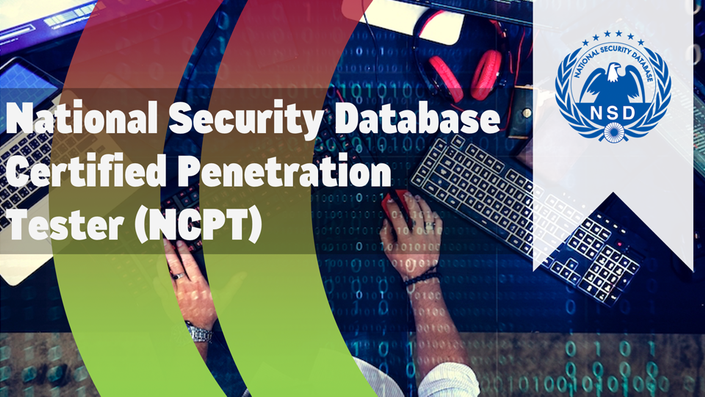1.2 Video Ethics and Culture- Defining a system (5:48)
1.3 Ethics and Culture (6:41)
1.1 Ethics and Culture
1.2 Overview of hacking history - Understand the evolution of hacking
1.3 Hacker Culture - Understand how hacker culture has evolved over time
Quiz 1
2.2 Video - Enterprise Security Challenges Part 2 (5:01)
2.3 Video - Enterprise Security Challenges- Adaptation (3:48)
2.4 Video - Enterprise Security Challenges- Evolution (6:14)
2.5 Video - Enterprise Security Challenges- Management Challenges (7:57)
2.6 Video - Enterprise Security Challenges- Security Concerns (6:01)
Quiz 2
3.2 Video - Information Gathering Part 2 (4:57)
3.1 Information Gathering: Introduction
3.2 What is Information Gathering?
3.3 Reconnaissance
3.4 Objective of Information Gathering
3.5 Information Gathering: Classification
3.6 Footprinting
3.7 Network-based Footprinting
3.8 Tools Used
3.9 DNS Enumeration
3.10 Scanning
Lab 1 - Version Detection using Nmap (2:22)
3.11 Scanning techniques
Lab 2 - User Enumeration (2:37)
3.12 Identifying Vulnerabilities
3.13 Countermeasures
Quiz 3
4.2 Video - Social Engineering- Into the Mind Inflicting Damage (7:42)
4.3 Video - Social Media Politics and Hacking (5:23)
4.4 Extra - Social Engineering- Exploiting Religion and Occult Science (6:52)
4.5 Extra - Social Engineering (4:31)
4.1 Introduction to Social Engineering
4.2 Understanding your targets - Basic approach in understanding your targets
4.3 Character Analysis - various approaches of character analysis
4.4 Body language - basic body language techniques
4.5 'Blink’ factor - Discussion on Instinct and Judgement on your targets
4.6 How SMS and Facebook has taken over our lives - Discussion on the impact of
4.7 Finding the right words
4.8 Chat addiction - Making a person attached to you on chat
4.9 Exploiting targets - Using the art effectively for gaining information
4.10 Possible Psychological damage - Discussion on possible psychological damag
4.11 Scripting in daily life: Games people play - Suggested reading of the book
4.12 Transactional Analysis - How can it help in networking and information gath
4.13 Introduction to Reality Hacking - Concept of reality hacking
4.14 Understanding reality hacking - Introduction and larger concept application
4.15 Weakest link in security - exploiting people
4.16 Application in real life - how "everything" around you can be used for hacking
4.17 Exploiting Religion and Occult Science: People and belief - Discussion on what is god, belief and religion
4.18 How religion plays a big role - Importance of religion in peoples lives
4.19 Understanding occult science - Brief introduction to occult science and what people believe
4.20 Astrology and daily life - How astrology impacts daily lives of people and their decisions
4.21 Faith - How to exploit faith for hacking
4.22 How to get personal information - Getting personal information in the name of god
4.23 Bluff master: How to be a palmist - effectively and instantly getting the secrets of people in your first meeting
4.24 Playing with the mind - How to induce self-fulfilling prophecies
4.25 Respecting the science - How not to cross the line
4.26 Into the Mind: Inflicting damage: Introducing hope - exploiting greed and success and fun and profit
4.27 Attachment in Adults - exploiting relationships for fun and profit
4.28 Turning people against each other - exploiting the weakest link
4.29 Phishing god - Using phishing and spam based on information gathered
4.30 Knowing your target - Crafting mails and messages to lure people
4.31 Social Media, Politics and Hacking
4.32 Importance of Social Media in opinion formation
4.33 Case Study: Politics and use of social media
4.34 Misleading people using Social Media
Lab 1 - Phishing using Shellphish (2:29)
Quiz 4
5.2 Video - System Security- Offensive Attacks (5:33)
5.3 Video - System Security - Wireless Security (4:37)
5.4 Video - Breaking WEP (3:48)
5.5 Video - Breaking WPA (4:59)
5.1 Systems Security
5.2 Group Discussion
5.3 Active directory fundamentals
5.4 Hiding Data - NTFS streaming
5.5 Wireless Security
5.6 Wireless security standards
5.7 WEP and inherent vulnerabilities
5.8 Sniffing Wireless networks
5.9 Breaking WEP
5.10 Breaking WPA
5.11 Wireless security – Best practices
5.12 Offensive attacks
5.13 Linux Privilege Escalation
5.14 Man in the Middle Attack
5.15 Finding Vulnerabilities
Lab 1 - Authentication Bypass Vulnerability (1:52)
Lab 2 - Gitshell Sandbox Bypass (2:14)
Lab 3 - Logic Vulnerability in libssh (2:00)
Lab 4 - Sandbox Bypass & Code Execution Vulnerability (2:33)
Lab 5 - Shellshock (1:55)
Lab 6 - Sudoexploit (1:54)
Lab 7 - WEP Cracking (1:41)
Lab 8 - WPA2 PSK Cracking (2:39)
Quiz 5
6.2 Video - Password Hacking 2 (4:23)
6.1 Password Hacking
6.2 Secret of passwords
6.3 Group Discussion: Do you use the same passwords everywhere?
6.4 Case study: The Most common passwords used
6.5 Team activity: Using online hash crackers
6.6 Attacking Windows system password
6.7 Attacking a Windows Server Domain Controller Password
6.8 Attacking Linux system password
6.9 Attacking Application passwords
6.10 Other approaches - Using Brute Force Tools
Lab 1 - Hydra Brute Force (2:10)
6.11 Steganalysis concepts
6.12 Using Rainbow Tables
6.13 Default Passwords of devices
6.14 Using Key loggers
6.15 Case Study: Impact of Default Passwords on Security
6.16 Team activity: Password recovery tools
Lab 2 - Directory listing and MD5 decryption (2:14)
Quiz 6
7.2 Video - Malware- Worm (4:55)
7.3 Video - Malware- Rootkits and Botnets (6:24)
7.1 Team activity: How would you define a Malware
7.2 Introduction to Malwares
7.3 What are Malwares?
7.4 Building a Trojan
7.5 Binding a Trojan to another file
7.6 Approaches for deploying a Trojan
7.7 Using Bit-torrent to spread Trojans
7.8 Anatomy of a Worm
7.9 Worm propagation process in a network
7.10 Defense against Worms
7.11 Worm Propagation possibilities in IPv6!
7.12 Rootkits and Botnets
7.13 Case study: How Botnets work?
7.14 Team activity: Find most popular malwares impacting the mobile platforms.
7.15 Rootkits Infection Techniques
7.16 Task: Analysis of a Malware.
Quiz 7
8.2 Video - Network- Honeypots (2:24)
8.3 Video - Network- Sniffing & Session Hijacking (6:20)
8.4 Video - Network-Web Application Security (5:52)
8.5 Video - Network- Advanced Google Search Techniques (3:10)
8.1 Network and Web Application Security
8.2 DDoS Attacks
8.3 Group discussion: DoS attacks impacting organizations
8.4 Targeting Firewalls and Routers
8.5 Defense - Clustering and NLB
8.6 Honeypots
8.7 Deploying Honeypots
8.8 Sniffing Networks
8.9 Encryption - Overview
8.10 Session Hijacking
8.11 Web Security
8.12 Web Application Attacks
8.13 Web Server Security
8.14 Web application security risk
8.15 Basic Authentication Attacks
8.16 Advanced Google Search Techniques
Lab 1 - Stored Xss (2:13)
Lab 2 - SQL injection (2:21)
Lab 3 - Reflected Xss (1:54)
Lab 4 - Remote Security Bypass (2:31)
Lab 5 - Remote code injection (2:20)
Lab 6 - Arbitrary code execution (2:08)
Lab 7 - Remote Code Execution Vulnerability-Drupal (1:55)
Lab 8 - Directory traversal Vulnerability (1:39)
Lab 9 - Remote Code Execution Vulnerability-ProFTPD (2:05)
Lab 10 - Remote Code Execution Vulnerability-ThinkPHP (1:50)
Lab 11 - Arbitrary File Read Vulnerability (1:38)
Lab 12 - Arbitrary Write-file Vulnerability (1:55)
Lab 13 - S2-007 Remote Code Execution Vulnerablity (1:37)
Lab 14 - Arbitrary File Download Vulnerability (1:35)
Lab 15 - RCE In GoAhead (2:08)
Lab 16 - Unauthorized Access Vulnerability (1:41)
Lab 17 - Unauthorized Access in Jupyter Notebook (1:36)
Quiz 8
9.2 Video - Exploiting Approaches - Advanced Exploitation (5:56)
9.3 Video - Exploiting Approaches- SMB Hacking & Anti Virus Evasion (5:46)
9.1 Exploiting Approaches
9.2 Overview of Shellcodes
9.3 Using exploit-db effectively
9.4 Metasploit - The Big Daddy
9.5 Introduction to msfencode/msfpayload
9.6 Manual Shellcode Writing and Automatic Shellcode Generation
9.7 Client Side Exploitation Techniques
9.8 Concept of Tunneling and Techniques
9.9 Evading Firewalls by hopping through the tunnels using proxy servers
9.10 SMB Fun – Windows and Linux
9.11 Anti Virus Evasion
Lab 1 - Code Injection Vulnerability (2:15)
Lab 2 - Path Traversal Vulnerability (2:08)
Lab 3 - Integer Overflow Vulnerability (1:38)
Lab 4 - Vertical Privilege Bypass Vulnerability (2:10)
Quiz 9
NSD Exam Format
Exam Terms
Quiz 10




